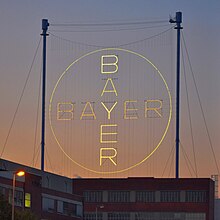Bayer cross
The oversized logo of the Bayer company in Leverkusen is known as the Bayer Cross ; it is the largest neon sign in the world. There are other, smaller Bayer crosses on other company premises (e.g. in Dormagen ).
history
The underlying trademark (logo) is over a hundred years old. The characteristic lettering was registered with the Imperial Patent Office on January 6, 1904 and replaced the lion emblem that had been used since 1881. The cross has been stamped on the packaging of medicines since 1910. In spring and autumn, the cross is regularly switched off for a few weeks at night between 10 p.m. and 4 a.m. so as not to irritate migratory birds. The Bayer plant in Dormagen also has a similar, smaller neon sign.
Even before the Second World War , there was a Bayer cross as a neon sign. This was erected in 1933 between two 126 meter high chimneys of a power plant and had a diameter of 72 meters. The press celebrated the cross in 1933:
"The largest illuminated advertising in the world is the Bayer-Kreuz large-scale light system at the Leverkusen plant owned by IG Farbenindustrie with a light circle 70 m in diameter."
In 1939 it was switched off as part of the war-related blackout measures and dismantled in 1944.
Today's Leverkusen neon sign was installed in 1958. It shows the Bayer company emblem and hangs on two 118 meter high steel masts. The diameter is 51 meters with a weight of 300 tons. In 2003 the Bayer cross was overhauled.
After the completion of the media facade of the Bayer skyscraper in 2009, the intention was to dismantle the Bayer cross and display it with 3.5 million light-emitting diodes on the facade of the skyscraper. It was also planned to erect a 200-meter-diameter Bayer cross on the BayArena in summer 2009 . These projects were (for the time being) stopped. There was resistance to the demolition of the cross in the Leverkusen population. Ultra groups of the Bundesliga soccer club Bayer 04 Leverkusen founded the “The Cross Must Stay” initiative, collecting signatures to show the public's interest in preserving the Bayer Cross and thus preventing its demolition. On December 4, 2007 Bayer announced that it would not tear the cross off.
In the first decades, 1712 40 watt incandescent lamps were used for lighting . Since the technology would have to be retrofitted anyway due to the ban on incandescent lamps, lamps based on light emitting diodes have been tested since May 2009 and installed in August and September 2009.
In 2016, the 1,710 LED luminaires in the wire rope construction were replaced by more modern and more efficient lamps. In this way, a further energy saving of 20 percent was achieved. At the same time, the cross became lighter again, because compared to the previous LEDs, the color and radiance now correspond to the previous incandescent lamp technology.
Individual evidence
- ↑ The Bayer Cross on the Bayer AG website, accessed on September 1, 2010.
- ^ Deutscher Hausschatz , Verlag Friedrich Pustet , April 1933, p. IV
- ↑ Bayer Cross shines in new energy-saving light. (No longer available online.) In: RP-online. August 7, 2009, archived from the original on September 19, 2009 ; Retrieved September 10, 2009 . Info: The archive link was inserted automatically and has not yet been checked. Please check the original and archive link according to the instructions and then remove this notice.
- ↑ The Bayer Cross - Logo and Landmark. In: Bayer AG website. January 11, 2018, accessed January 11, 2018 .
Web links
- Information on the Bayer Cross at leverkusen.com
- Bayer cross. In: Structurae
- Article in the Kölner-Stadt-Anzeiger about the conversion to light-emitting diodes
- Entry on Bayer-Kreuz Leverkusen in the database " KuLaDig " of the Rhineland Regional Association
- Entry on the First Bayer Cross (pre-war Bavarian Cross in Leverkusen) in the " KuLaDig " database of the Rhineland Regional Council
- Entry on Bayer cross in Uerdingen in the database " KuLaDig " of the Rhineland Regional Association
- Entry on Bayer Cross at Cologne / Bonn Airport in the " KuLaDig " database of the Rhineland Regional Association
Coordinates: 51 ° 1 ′ 19.9 ″ N , 6 ° 59 ′ 18.5 ″ E

